
Photos by Yusuke Uchiha – @y_u.photography
2018 S/S was the first time beloved designer Takahiro Miyashita ever brought his eponymous collection to a runway show since founding the label nearly eight years ago. His restyled catwalk reprisal (since Paris) was one of the most anticipated shows of Tokyo Fashion Week, opening with the tender rawness of Suzanne Vega’s classic a cappella verses as time seemingly stopped and beckoned the audience to lean in. (see Honeyee US’s show coverage here)
Miyashita san had decided not to take any interviews this season, but somehow obliged our request one rainy afternoon a few days after the show. We met him at his Tokyo atelier, his ribs still tender from a pre-show fall in the studio but despite this, looking cool and collected as usual. Setting up camp in a quiet coffee shop next door, we gathered around a table by the window, pre-typhoon weather gently roaring outside.
It’s been awhile since you’ve done a runway show. How do you feel?
Tired. Tired…but…good.
What are the main words you would use to describe yourself during the show?
Beautiful, nervous…a little bit excited. Maybe happy. A little bit.
Not a lot happy?
I don’t know yet. I’m still digesting everything.
For me the show was very interesting. I wanted to see your show live—I always see it in magazines or videos—I’ve never seen it in person. So when I went to the show, there was music for two [seemingly long] minutes—
That’s my style. Two and a half minutes. Like usual.
Before the show starts…
Super important time for me.
When you chose the song, was it meant to give the audience an emotion? How the show was going to feel?
You have to confuse everyone and make them focused. I also need to be focused. So that time before the show—the intro—I also need to be focused, concentrated. It’s an extremely important time for both the viewers and those putting on the show. It’s not only about showing the clothes—music is also a very important element for the show. Everything…how you use time… The show starts from the moment you wake up.
Usually when I go to a fashion show, everyone’s talking and they tell you to sit. You sit, the music starts, and the clothes come out. With your show you sit, the show starts, and there’s two minutes for me to let go of everything, meaning, I don’t have think about what I did today, what I want to do later—I’m zoned in and the music brings me into the emotion of what he’s trying to encapsulate with the show. Was that his intention? To escape?
Yes.

It was very…successful [in that way] because there was anticipation but at the same time it was giving me a feeling. The hook of the song (Tom’s Diner by Suzanne Vega) was cut out until the end… It gave the audience some time to let go of everything that they were dealing with in their regular life and focus on what Miyashita wanted to present to us…
That’s exactly right. The part you noticed that was changed was because I hadn’t decided where to end it yet. I extended the “doo doo doo doo” part longer, so I could fade out from any part. We didn’t know… and I didn’t know from where we could start, because it was the first time [showing] in nine years. So I was pretty nervous, there was the possibility I wouldn’t be prepared yet. But after we opened, I became impatient and people were waiting in the cold, so I let the music start. I couldn’t help it.
Edison, you know me very well, you don’t even have to ask questions…
“You have to confuse everyone and make them focused…The show starts from the moment you wake up.”
Was there any specific imagery that you wanted people to experience in the show through the music [throughout]?
Ah, that’s a good question; I was waiting for that!
It’s always the same: as with my past shows, I’d already shown the collection with the lookbook. As we were shooting, I was already thinking “oh there will be a show in Tokyo,” everyone will have seen it already. If that’s the case, then I don’t want to do a same thing—you don’t want to do something expected. So I tried to leave the invitation mysterious [since NUMBER (N)INE, Miyashita’s style had been to create invitations that have nothing to do with the actual show]. Like in the last show there was ice cream or parfait…I want to make people confused. I wanted to betray them, in a positive way. Everyone took the trouble to come all the way out—which I’m grateful and happy for—but if you do something expected, no one will be happy. I want to surprise people who were also at the Paris show, that’s why I did that kind of thing. I don’t want to do something pre-established. That’s what a show is.
The press release mentioned that designs were based on western-style “costumes” rather than western-style “workwear” – why was the choice made to focus on something more imaginary?
I’m not sure, I have to go back my daily process during the time I was designing the collection. There are various types of western clothes—even beyond western clothes, there are so many different styles to draw inspiration from. Within this collection, one focus was the polyester suit: why is polyester considered cheap? Isn’t there a way to make a beautiful suit out of polyester? If you design a beautiful suit, then whether you use good quality fabrics or polyester, it would look good no matter what. During the time I was creating this collection, I focused on polyester because I personally think it is a good material. I intentionally leaned more towards the costume style of western culture not just a cowboy… How should I put this? They are not clothes for cowboys in regards to formal attire [or workwear]—but rather for dancing two-step at night…midnight cowboys were what I imagined.

Was it meant to be more romantic?
Always… romance or darkness – these are the signature elements in my clothes. Those two are on the same level. Maybe it’s something with Japanese designers, like Jun [Takahashi]. Undercover might be cute but it might also be scary; they’re mixed. For me, it’s the idea of romance and darkness. Always.
You speak specifically about darkness and “romance”—not darkness and “light”—why do you specifically use this differentiation?
I would never choose light. Maybe for me the opposite of darkness is beauty… As an expressionist I don’t have that idea of lightness or brightness. Please understand, I’m not trying to bring people down, I of course want them to be happy. But when it comes to creating [a collection], maybe I don’t have those elements in me…
So is there the relationship between darkness and romance in his life? Besides in his clothing, his creations—is darkness and romance the ultimate positive and negative in his life mindset?
Yes. At this moment.
“Maybe for me the opposite of darkness is beauty…”
So if you had to imagine some kind of light, what would it be?
I’ll think about that after I’ve retired.

One of the most memorable features of the show were the Kool-Aid-inspired toys being carried by the models? What was the idea behind them? Where did they come from and what was their connection to the collection?
That is Kurt Cobain, sometime in the 90’s. Here’s a photo of him holding the original Kool-Aid toy.
Kurt is a muse for you—he’s almost a constant… What does Kurt Cobain represent to you?
I don’t know…he’s inside, a part of me almost.
Not only Kurt—I’m influenced by a lot of people—but this specific collection could never had been made without him. John Lennon and Kurt are constant themes, but I’ve already made damaged jeans or flannel shirts a long time ago. Maybe people are expecting these staples, but I’ll never do them again. This time, creating a different kind of Kurt Cobain was one of the main goals.
For a lot of kids who grew up listening to him, Kurt represented constant struggle. Is that struggle and journey a vital part in your collection?
YES.
Do you have a definitive, favorite Kurt Cobain moment?
(laughs) That’s a hard question. It’s like being asked what your favorite Beatles song or album is. That changes time to time.
That’s fair, that’s fair! So that Kool-Aid reference was a nice easter-egg for those in the know—but it was also an almost “joyful” representation of Kurt. Like you mentioned, when people think of Kurt Cobain, they might usually think of flannels, but the Kool-Aid is this funny, off-moment…
I used it as a joke.
You were referencing what’s going on in America right now… It’s all fluff…everything’s a joke right now in America, when you look at the news, when you look at what the president is saying—almost everything about America right now. It doesn’t feel real. Was this what you were trying to say?
Not really; it was not intended that way. Using the vinyl to cover looks that had previously been seen was what I already had in mind. The idea covering with PVC vinyl was decided in July. But even after the vinyl concept there was something missing. And it was Kool-Aid.
So the PVC was to cover but not cover? It was a barrier…a filter…?
Yes, the idea is contradictory. In one sense it’s not showing to people who want to see, but you can actually still see through [the vinyl] where I was actually still showing the styling and details. In this way, the vinyl is also a message to look more carefully. It’s was a dual message, hiding the subject while challenging viewers to look more carefully. I wanted to people to see, but I also wanted them to focus.
The graffiti artist that was writing on the clothing – he’s a guy from Fukuoka right? The patchmaker—I went on his Instagram—there’s no patches… And then you work with Syn Murayama, who is also a not very well known artist, clothing maker—how does he find these people? Over the years, when Miyashita does a collaboration with someone is when I find out about them and then I become a fan of them. Are these his friends? Or does he find them because of his craft?
I’m very lucky to meet all kinds of talented, interesting people. Typically, if they’re interested [in me / my brand], they approach me. I want to say something about this…

I’ve always wanted to challenge the status quo as an independent. I don’t necessarily intentionally work with independent brands, but oddly they come to me. Maybe it’s because they share the same mindset. I’m independent, they’re independent. I think they also want to challenge the status quo, so we have kindred spirits. People who can understand me come closer to me, so I’ve never had to exert effort in to finding them.
Who is Oscar?
Is Oscar your muse? Does he inspire you? Is he your godchild?
He’s my best friend. He’s the son of a woman who used to work at NUMBER (N)INE.
[Oscar is a recurrent name and theme that has appeared throughout TheSoloist. collections. Periodically you’ll see Oscar, a child as it turns out, on his Miyashita’s personal Instagram.]When you’re making clothes? How does he influence you? When I see photos he posts of Oscar, they’re very happy… Is he a very positive influence in your life?
Yes. He’s family.
Have you known him since he was a baby?
Yes.
So you treat him like your family…
Oscar…is the Soloist…
Oh wow… so around the time TheSoloist started he was born?
Ah…that’s right. He’s the same age as TheSoloist. So they kind of grew up together.

Photo by Yusuke Abe (YARD)
“Oscar…is the Soloist…”
We have a few easy questions – who’s your favorite rapper?
Right now, X.
X…XXXTENTACION?
Yes. I’ve got his Mickey Mouse tee shirts. There are many good musicians I like but at this stage, I am listening to his stuff. But my mood changes all the time, so I will probably be listening to someone else tomorrow.
What’s your favorite sneaker? Shoe?
Sneaker…? Nothing.
Shoe?
Shoes, right now, Flip-Flops. OOFOS. They’re the best, good product. And Soft Science. Both of them are like…for people who can’t walk…
What’s your favorite food?
Soba? I guess.
What’s your favorite city?
None.
American city?
Right now…? I always like San Francisco. It doesn’t change. Nothing happens in San Francisco. I like that.
This is something I’ve been wanting to ask you: I talk to rappers, A$AP Rocky, black designers, and ask them “who is your favorite designer?” “Miyashita san.” Wow, how do you even know about him? So does it surprise you that—your aesthetic is very grunge, rock—all these hip hop guys love you – how do you feel about that?
That makes me very happy. That makes me very, very happy
Do you have anything to say to them? Because every time it shocks me. Every time I think it’s going to be someone else, it’s usually you. They come to Japan and ask me where to buy your old clothing—I tell them I don’t know, even I want to buy some—so I feel like you’re so important to these kids, I wanted to see if you have anything to say to them because they look up to you…
It’s more than thank you… Sincerely, thank you. Hearing that makes me super happy. That’s a designer’s happiest moment: it’s a joy if you can change people’s mind and feelings with your clothes.
I talk to rappers, A$AP Rocky, black designers, and ask them “who is your favorite designer?” “Miyashita san.”
So there’s a new generation of kids who are inspired by you. When you were young, who was your Miyashita san?
(laughs) I don’t know. I don’t remember who I looked up to at that age. But if I was part of the younger generation right now, I definitely wouldn’t look up to me. (laughs) Not me.
Anything you’ve ever created, what is your favorite creation?
The entire process of creation is my favorite. It can be music, architecture—it doesn’t matter.
Could you elaborate on the process?
There is no right or wrong way. I’m still learning…I still haven’t found my of creative process. That’s why I keep on creating, I’m still studying, learning how I can find my own way. If I found the answer, I would stop doing this job. I just like imagining and creating something.
More than that, I’m trying so hard to be unfinished. If you are in an imperfect state—referring to Oscar again—a 7-year-old is imperfect. He is growing. If that continues forever…that’s so perfect. Being imperfect is the most perfect human being. That’s so important in your life.
Last question. When you are designing, are you listening to music or not listening to music?
Both. Sometimes I listen to music and sometimes I don’t. My father is a composer.
What are the notes on the inside of the pants you make? What do they stand for? What do they mean?
You have to play them.
Miyashita smiles and stands up from the table.






















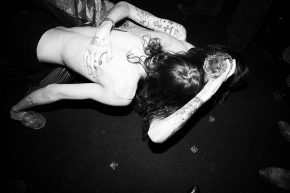
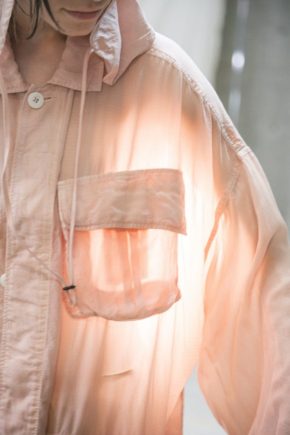
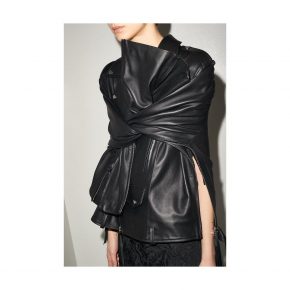
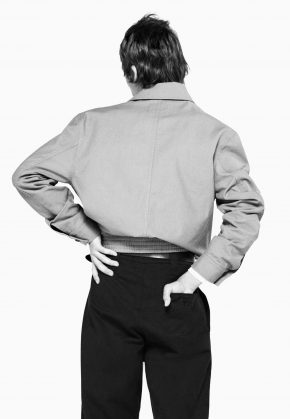
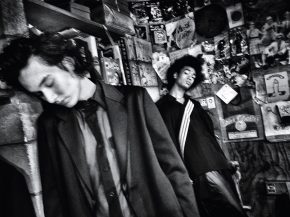
Comments